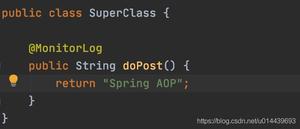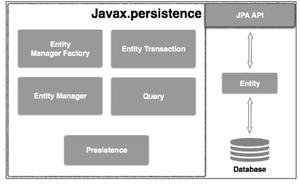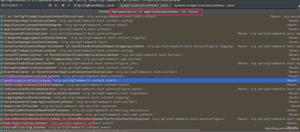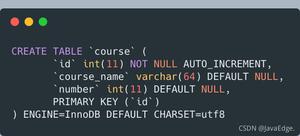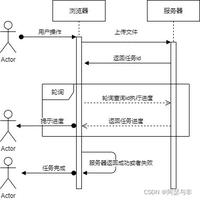Spring中注解的使用详解
本文内容纲要:Spring中注解的使用详解
一:@Rsource注解的使用规则
1.1.案例演示
Spring的主配置文件:applicationContext.xml(因为我这里将会讲到很多模块,所以我用一个主配置文件去加载各个模块的配置文件):
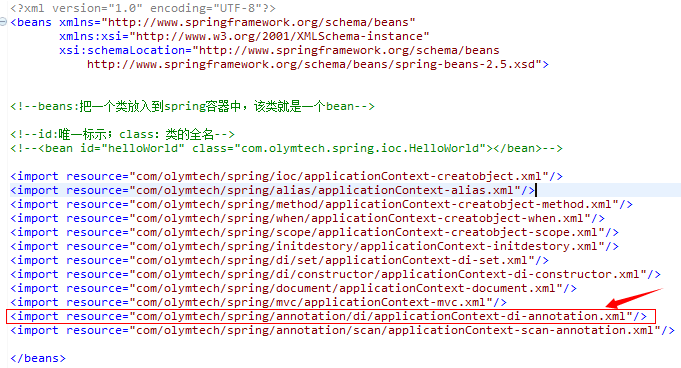
具体业务模块配置文件applicationContext-di-annotation.xml
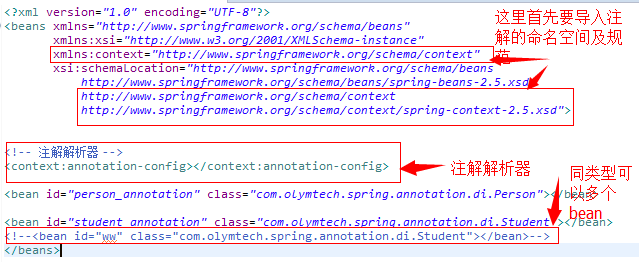
业务类Person.java和Student.java
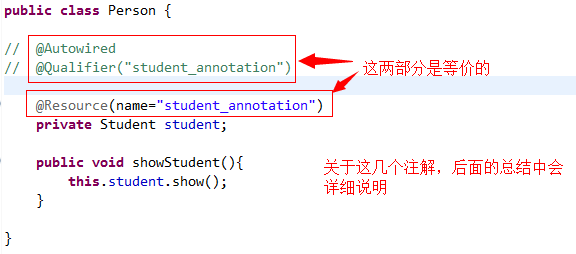
---------------------------------------------------------------------------------------------------------------------------------------

客户端代码:

执行结果是:student_annotation
1.2.使用总结
A:@Resource使用规则:
1.在spring的xml配置文件中导入命名空间及规范。
xmlns:context="http://www.springframework.org/schema/context"
http://www.springframework.org/schema/context
http://www.springframework.org/schema/context/spring-context-2.5.xsd
2.在spring的xml配置文件中引入注解解析器。
context:annotation-config</context:annotation-config>
3.在spring的xml配置文件中把bean引入进来。
4.在一个类的属性上加
@Resource(name="student_annotation")
public Student student;
从该注解本身
@Target({TYPE, FIELD, METHOD})
@Retention(RUNTIME)
public @interface Resource {
String name() default "";
}
可以看出:1.该注解可以用于属性或者方法上,但一般用于属性上。2.该注解的作用范围是runtime。3.该注解有一个属性name,默认值为“”。
有点要注意@Resource注解只能作用于引用类型的属性上。
B:加入了注解之后的整个执行过程:
1.当启动spring容器的时候,spring容器加载了配置文件。
2.在spring配置文件中,只要遇到bean的配置,就会为该bean创建对象。
3.在纳入spring容器的范围内查找所有的bean,看哪些bean的属性或者方法上加有@Resource。
4.找到@Resource注解之后,判断该注解的name属性是否为“”(name没有写)
如果没有写name属性,则会让属性的名称和spring容器中bean的Id值做匹配,匹配成功则赋值;如果匹配不成功,则按照类型匹配,如果匹配不成功,就报错。
如果写了name属性,则会按照name属性的值和spring的bean中ID进行匹配,匹配成功,则赋值,不成功则报错。
C:@Resource与@Autowired
@Resource与@Autowired都是做bean的注入时使用。其实@Resource并不是spring的注解,它是jdk扩展包javax.annotation.Resource中的,需要导入使用,但spring支持该注解的使用。
1.@Autowired
@Autowired为Spring提供的注解,需要导入包org.springframework.beans.factory.annotation.Autowired;只按照byType注入。
@Autowired注解是按照类型(byType)装配依赖对象,默认情况下它要求依赖对象必须存在,如果允许null值,可以设置它的required属性为false。
如果我们想使用按照名称(byName)来装配,可以结合@Qualifier注解一起使用 ,如下:
@Autowired
@Qualifier("student_annotation") 等价于 @Resource(name="student_annotation")
2.@Resource
@Resource默认按照ByName自动注入,由J2EE提供,需要导入包javax.annotation.Resource。 @Resource有两个重要的属性:name和type,而Spring将@Resource注解的name属性解析为bean的名字,而type属性则解析为bean的类型。 所以,如果使用name属性,则使用byName的自动注入策略,而使用type属性时则使用byType自动注入策略。 如果既不制定name也不制定type属性,这时将通过反射机制使用byName自动注入策略。
二:使用注解把一个类放到spring容器中
2.1.案例演示
Spring的主配置文件:applicationContext.xml(因为我这里将会讲到很多模块,所以我用一个主配置文件去加载各个模块的配置文件):
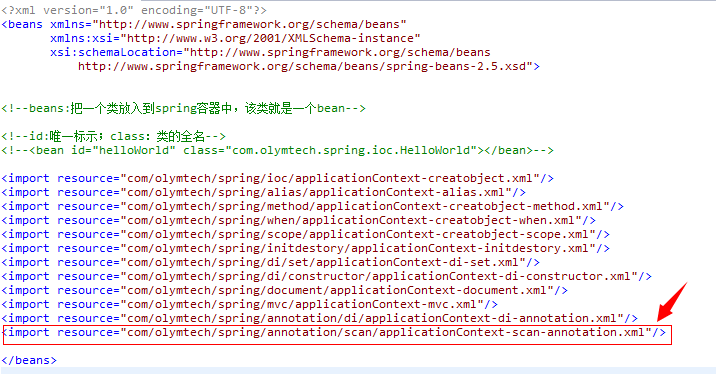
具体业务模块配置文件applicationContext-scan-annotation.xml

业务类Person.java和Student.java
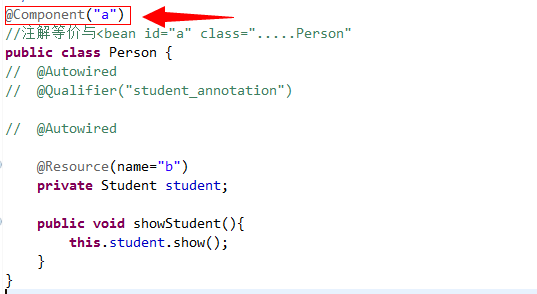
-----------------------------------------------------------------------------------------------------------------------------------

客户端代码:

执行结果:student_annotation
2.2.使用总结
A:@Component的使用规则
1.在spring的配置文件中导入命名空间及规范
xmlns:context="http://www.springframework.org/schema/context"
http://www.springframework.org/schema/context
http://www.springframework.org/schema/context/spring-context-2.5.xsd
2.引入类扫描及注解解析器
<context:component-scan base-package="com.olymtech.spring.annotation.scan"></context:component-scan>
a:该注解解析器包含了两个功能:依赖注入和类扫描(包含了context:annotation-config</context:annotation-config>)
b:base-package:在该包及子包中扫描
3.如果一个类或者接口上(一般都是类上),加了@Component注解,就会进行如下法则:
如果其value属性的值为“”
@Component
public class Person(){
}
等价于
如果其value属性的值不为“”
@Component("p")
public class Person(){
}
等价于
4.按照上面的@Resource法则再次进行操作。
2.3.注解与XML的区别
A:注解书写简单,但效率低(应为解析器要扫描类注解,完了再扫描属性注解),但比起网络的效率,它完全可以忽略不计(你服务器效率再高,我提交一个http请求,咔,网断了,或网络阻塞,服务器效率再高有啥用?) 。
B:xml书写麻烦,但效率高(不存在扫描)
三:类扫描注解和依赖注入注解联合使用
2.1.Document文档读写案例演示
Spring的置文件:applicationContext-document.xml:
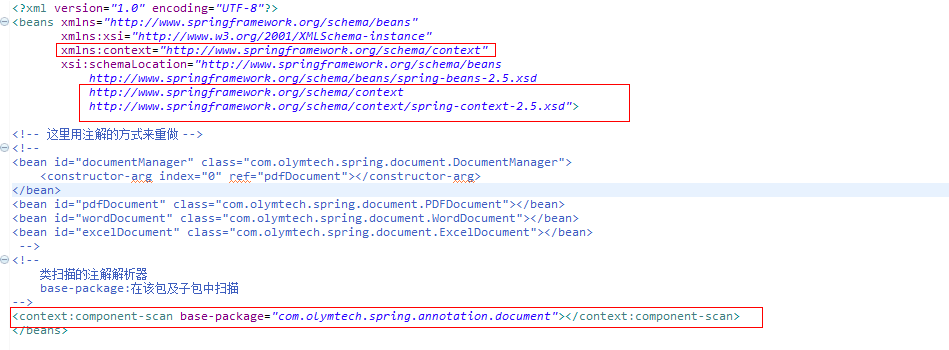
业务类:Document接口,DocumentManager类,ExcelDocument类,PdfDocument类,WordDocument类
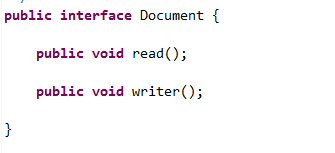
------------------------------------------------------------------------------------------------------------------------
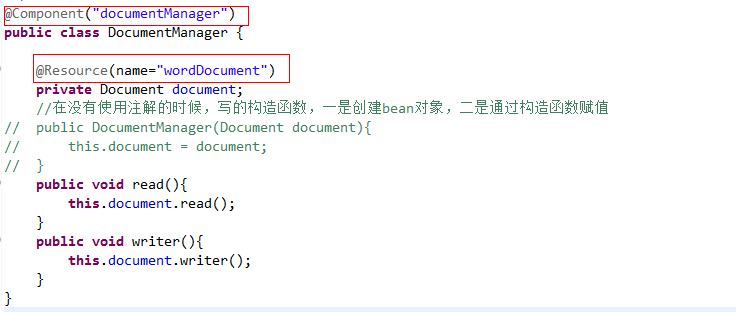
----------------------------------------------------------------------------------------------------------------------------
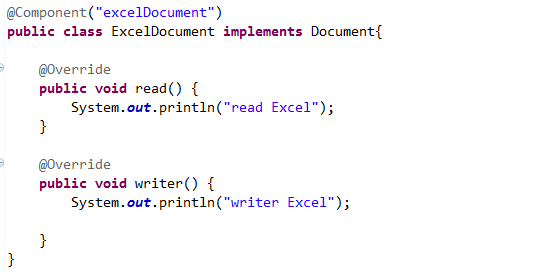
------------------------------------------------------------------------------------------------------------------------------
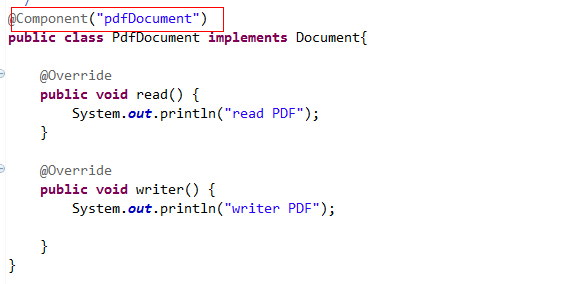
--------------------------------------------------------------------------------------------------------------------------
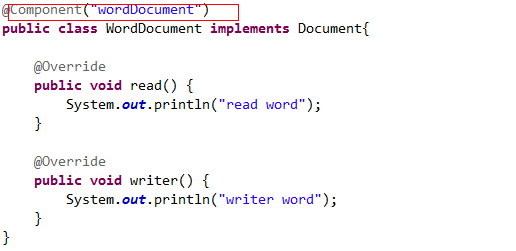
--------------------------------------------------------------------------------------------------------------------------------------
客户端代码:

执行结果:read word
writer word
2.2.模仿web的MVC案例演示
Spring的置文件:applicationContext-mvc.xml:
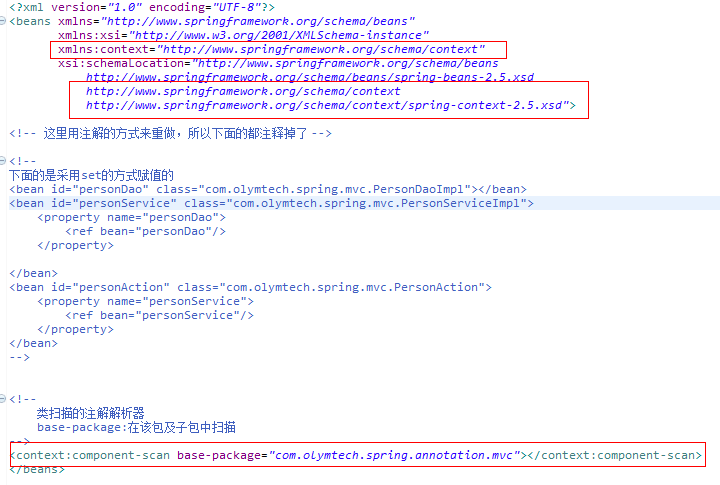
业务类:
控制层:
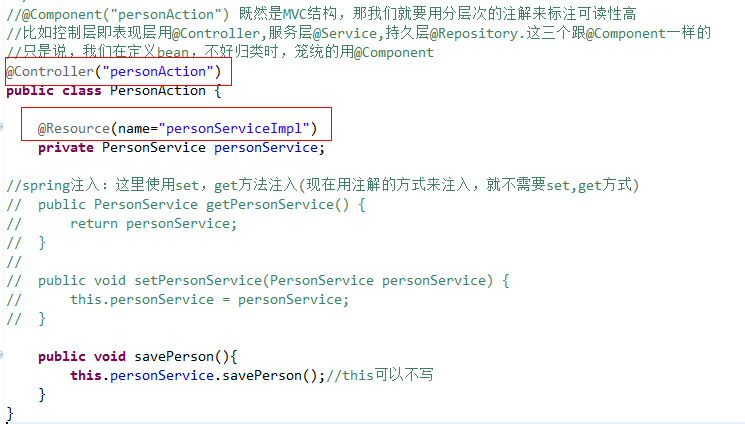
服务层:

-----------------------------------------------------------
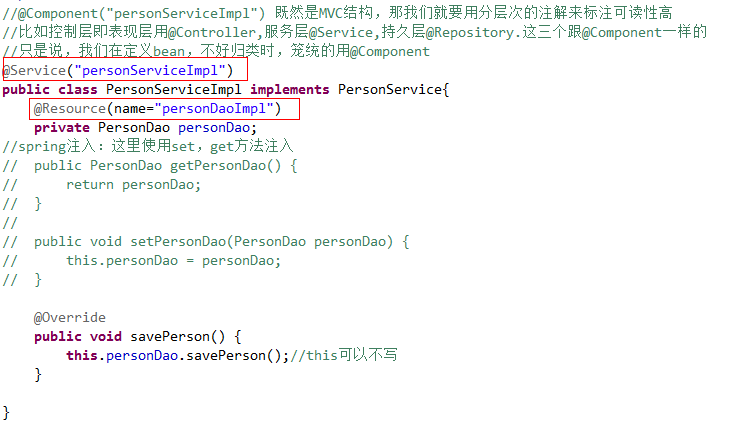
持久层:

--------------------------------------------------------

客户端代码:

执行结果:save person dao
四:spring中关于类扫描注解和依赖注入注解的归纳总结
Spring 2.5引入了更多典型化注解(stereotype annotations): @Component、@Service和 @Controller。 @Component是所有受Spring管理组件的通用形式; 而@Repository、@Service和 @Controller则是@Component的细化, 用来表示更具体的用例(例如,分别对应了持久化层、服务层和表现层)。也就是说, 你能@Component来注解你的组件类, 但如果用@Repository、@Service 或@Controller来注解它们,你的类也许能更好地被工具处理,或与切面进行关联。 例如,这些典型化注解可以成为理想的切入点目标。当然,在Spring Framework以后的版本中, @Repository、@Service和 @Controller也许还能携带更多语义。 如此一来,如果你正在考虑服务层中是该用 @Component还是@Service, 那@Service显然是更好的选择。 同样的,就像前面说的那样, @Repository已经能在持久化层中进行异常转换时被作为标记使用了。
-----------常用注解--------
--定义Bean的注解(类扫描注解)
@Controller
@Controller("Bean的名称")
定义控制层Bean,如Action
@Service
@Service("Bean的名称")
定义业务层Bean
@Repository
@Repository("Bean的名称")
定义DAO层Bean
@Component
定义Bean, 不好归类时使用.
--自动装配Bean (依赖注入注解;选用一种注解就可以)
@Autowired (Srping提供的)
默认按类型匹配,自动装配(Srping提供的),可以写在成员属性上,或写在setter方法上
@Autowired(required=true)
一定要找到匹配的Bean,否则抛异常。 默认值就是true
@Autowired
@Qualifier("bean的名字")
按名称装配Bean,与@Autowired组合使用,解决按类型匹配找到多个Bean问题。
@Resource JSR-250提供的
默认按名称装配,当找不到名称匹配的bean再按类型装配.
可以写在成员属性上,或写在setter方法上
可以通过@Resource(name="beanName") 指定被注入的bean的名称, 要是未指定name属性, 默认使用成员属性的变量名,一般不用写name属性.
@Resource(name="beanName")指定了name属性,按名称注入但没找到bean, 就不会再按类型装配了.
@Inject 是JSR-330提供的
按类型装配,功能比@Autowired少,没有使用的必要。
--定义Bean的作用域和生命过程
@Scope("prototype")
值有:singleton,prototype,session,request,session,globalSession
@PostConstruct
相当于init-method,使用在方法上,当Bean初始化时执行。
@PreDestroy
相当于destory-method,使用在方法上,当Bean销毁时执行。
--声明式事务
@Transactional
本文内容总结:Spring中注解的使用详解
原文链接:https://www.cnblogs.com/vanl/p/5614711.html
以上是 Spring中注解的使用详解 的全部内容, 来源链接: utcz.com/z/296104.html


